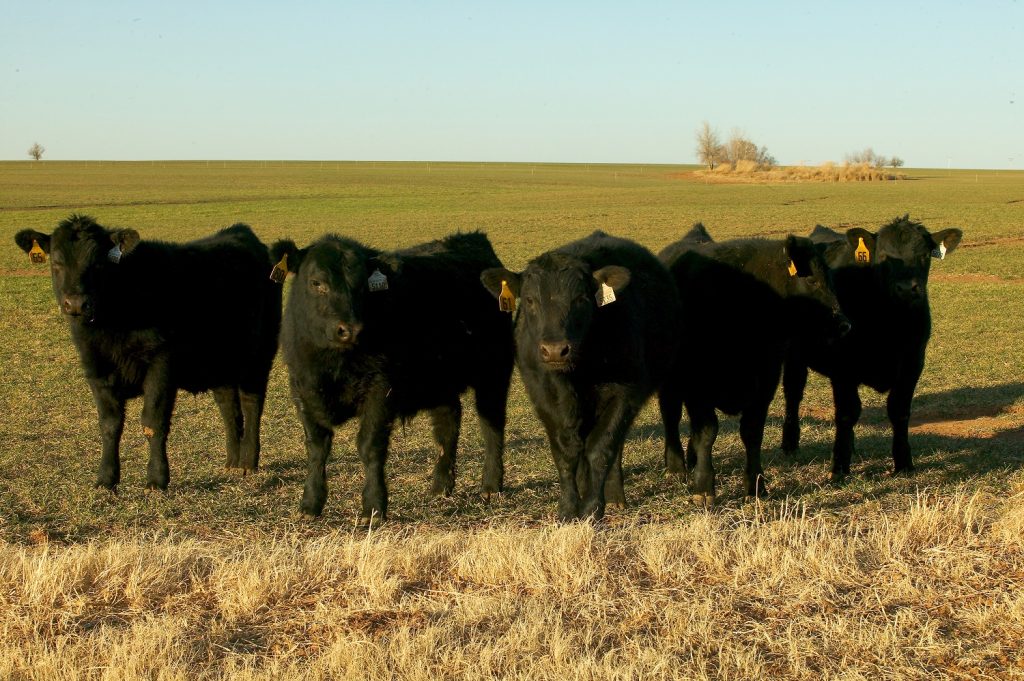
Weekly, Oklahoma State University Extension Beef Cattle Nutrition Specialist Paul Beck offers his expertise on the beef cattle industry. This is part of the weekly series known as the “Cow Calf Corner,” published electronically by Dr. Derrell Peel, Mark Johnson, and Beck. Today, he discusses how many calves can be grazed when wheat pasture is limited.
Last week, I discussed that we can increase the performance of growing calves on wheat pasture by providing a small amount of a concentrate supplement carrying an ionophore and minerals that are deficient in wheat pasture (https://extension.okstate.edu/programs/beef-extension/cow-calf-corner-the-newsletter-archives/2024/december-16-2024.html). In many areas of Oklahoma and the Southern Plains, wheat pasture this year has yielded much less than our normal expectations, but there are economic incentives to graze as many calves on pasture as possible this winter. Additionally, there are several options available to offset the reduced forage allowance of wheat pastures this winter and maintain the expected gains of grazing calves.
- Using a Self-Fed Supplement. Providing grains or byproduct feeds free-choice in a bulk feeder has historically been an option when feed is cheap. Even though there is risk in feeding free choice, providing whole corn or ground grain sorghum choice results in as fed intake of 1.5 to 2.0% of bodyweight with doubling of stocking rates. This resulted in increased performance but required 9 to 10 pounds of concentrate supplement per pound of added gain. Based on current prices of calves and futures prices on feeders, the calculated value of gain is conservatively around $1.20 per pound. For a self-fed concentrate supplement to break even, feed costs should be $241/ton or less ($6.75/bushel of corn) which may work if you have corn or other feed grains locally available.
- Hand-Feeding at a Moderate Supplement Rate. Research from the OSU Wheat Pasture Research Unit at Marshall (Horn and others 1995, Journal of Animal Science Volume 73, https://doi.org/10.2527/1995.73145x) showed that providing a concentrate supplement (based on either corn or a soyhull/wheat middling blend) containing monensin at 0.65 to 0.75% of body weight (for example, 4 pounds per day for a 533-pound steer) increased potential stocking rate by 33% and weight gains by 0.3 pounds per day. The increased stocking rate and increase in performance of grazing calves is a powerful economic tool in managing wheat pasture, with supplemental efficiency of 5 pounds of supplement required per pound of added gain per acre.
This supplementation program can also be used to “stretch” wheat forage when pastures were 60 to 80% of normal, allowing for “normal” stocking rates. Recently researchers at OSU (McNeill and others, 2020, Journal of Animal Science, Volume 98, https://doi.org/10.1093/jas/skz397.023) stocked steers on wheat pastures at forage allowances of either 1.5 or 3 pounds of forage DM/pound of steer bodyweight with or without 3.3 pounds per day of a wheat middling/soyhull feed blend. Steers on the higher forage allowance (3.0 lbs forage DM/ lb steer bodyweight) with supplementation gained the most (3.8 lbs/day) while unsupplemented steers on the higher forage allowance gained 3.6 lbs/day. Supplementation increased gains more for steers at the lower forage allowance where gains of steers stocked at forage allowance of 1.5 lbs forage DM/lb steer bodyweight increased from 2.5 to 3.2 lbs/day with supplementation.
- Using Good Quality Hay or Silage. Intake of low-quality roughages is not high enough to offset wheat forage intake and can reduce performance of growing calves, but in the 1980’s, research showed that offering high quality roughages such as corn silage or sorghum double stocking rates on wheat pastures. This research was repeated by offering bermudagrass round bale silage to steers stocked at 1, 1.5 or 2 steers per acre with forage allowances going from 2.9 to 1.2 lbs forage/lb of bodyweight (Beck and others, Applied Animal Science, 2023, Volume 40, https://doi.org/10.15232/aas.2023-02466). Offering round bale silage at the lowest stocking rate actually increased gains compared with steers at the same stocking rate without silage (3.15 vs 2.79 lbs/day). As we increased stocking rate, average daily gain decreased, but total gain per acre increased by 52% when stocking rates were doubled. Based on this research, we should be able to maintain our normal stocking rates on wheat pasture during the fall and winter with adequate ADG by feeding moderate quality forages even if wheat forage production is 50% below our normal expectations.
There are some feeding options available to us when the economic conditions are right, but forage conditions are lacking. Feeding either limited concentrate supplementation or moderate quality roughage during the fall can increase production stability and thus improve economic stability of the wheat stocker enterprise.


















